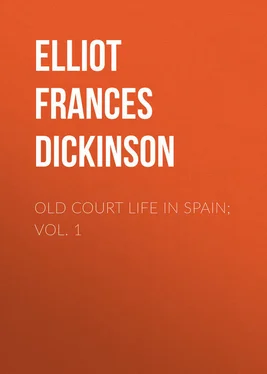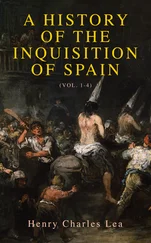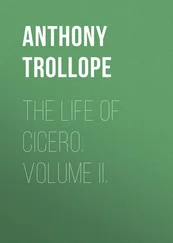Frances Elliot - Old Court Life in Spain; vol. 1
Здесь есть возможность читать онлайн «Frances Elliot - Old Court Life in Spain; vol. 1» — ознакомительный отрывок электронной книги совершенно бесплатно, а после прочтения отрывка купить полную версию. В некоторых случаях можно слушать аудио, скачать через торрент в формате fb2 и присутствует краткое содержание. Жанр: foreign_antique, foreign_prose, на английском языке. Описание произведения, (предисловие) а так же отзывы посетителей доступны на портале библиотеки ЛибКат.
- Название:Old Court Life in Spain; vol. 1
- Автор:
- Жанр:
- Год:неизвестен
- ISBN:нет данных
- Рейтинг книги:4 / 5. Голосов: 1
-
Избранное:Добавить в избранное
- Отзывы:
-
Ваша оценка:
- 80
- 1
- 2
- 3
- 4
- 5
Old Court Life in Spain; vol. 1: краткое содержание, описание и аннотация
Предлагаем к чтению аннотацию, описание, краткое содержание или предисловие (зависит от того, что написал сам автор книги «Old Court Life in Spain; vol. 1»). Если вы не нашли необходимую информацию о книге — напишите в комментариях, мы постараемся отыскать её.
Old Court Life in Spain; vol. 1 — читать онлайн ознакомительный отрывок
Ниже представлен текст книги, разбитый по страницам. Система сохранения места последней прочитанной страницы, позволяет с удобством читать онлайн бесплатно книгу «Old Court Life in Spain; vol. 1», без необходимости каждый раз заново искать на чём Вы остановились. Поставьте закладку, и сможете в любой момент перейти на страницу, на которой закончили чтение.
Интервал:
Закладка:
Frances Elliot
Old Court Life in Spain; vol. 1/2
IN no boastful spirit I gratefully acknowledge the flattering success of Old Court Life in France , written twenty years ago. It is precisely owing to the favour with which the public in England, America, and on the Continent still honour this work that I have endeavoured to reproduce on the same plan some pictures of early Spanish history comparatively little known to the general public.
Nothing can possibly be more thrilling and more romantic.
It is with the earlier and less known passages of old Court life I have dealt down to the reign of Ferdinand and Isabel, from which period the history of Spain loses its peculiar identity and becomes merged into that of Europe.
If I have loved the courtly history I also love the country. A great part of this work was written in Spain, in the very places where the events occurred. May the reader share the same enthusiasm I felt in describing them!
Dozy – Histories.
Mrs. Humphry Ward in Smith’s Dictionary of Christian Biography on Gothic Ecclesiastical History.
Biographie Universelle.
Bradley – Story of the Nations.
Lane Poole – The Moors.
Romanceros, Ballads of the Cid, Ballads of Bernardo del Carpio.
Lockhart – Spanish Ballads.
Cid Campeador, by Prince Odescalchi.
Storia de Don Pedro Abogado da los Tribunales Nacionales.
Chronicles of King Alfonso El Sabio.
Washington Irving’s Works.
Murray’s Guide for Spain.
Diary of an Idle Woman in Spain.
Prescott’s History of Ferdinand and Isabel.
CHAPTER I
Introduction
HOW great is Spain! How mighty! From the rugged mountains of the Asturias, their base washed by stormy waves, and the giddy heights of the Pyrenean precipices – an eternal barrier between rival peoples – to the balmy plains of the South, where summer ever reigns! A world within itself, with a world’s variety! Quien dice España dice todo!
And its history is as varied as the land. First, according to the legend, Hercules set his pillars, or “keys” – the ne plus ultra of land and sea – on the rock of Calpe (Gibraltar) in Europe, and on Abyla (Ceuta) in Africa. And, that no one should doubt it, he placed his temple on the water-logged flats, half-sea, half-land, behind Cadiz, long remembered by the Moors as the “district of Idols,” near the city of Gades, where Geryon dwelt, from whom Hercules “lifted” that troop of fat oxen which he was destined so long to drive wearily about the earth. In memory of all which Charles the Fifth, the great Emperor, carried Hercules’ pillars on his shield, with the proud motto, Ne plus ultra , and the city of Cadiz (Gades) still bears them as its arms.
Then, tradition past, came invaders from the earliest times, Celts, Phœnicians, and Greeks, driving the Iberians from their rightful lands. The Carthaginians, too, crossed from Africa along the southern coast, and settled at Cartagena, which still bears their name.
The Romans next appeared, victorious under Pompey and Cæsar, spreading over Spain, but especially powerful at Seville, Cordoba, Toledo, Segovia, and Tarragona, where they have left their mark in mighty monuments.
A race of uncivilised warriors followed from the North, so powerful that two Roman emperors perished in battle with them. Of the precise seat of the Gothic nation it is hard to speak with certainty. It is, however, known that they came from the extreme north, spreading to the borders of the Black Sea, into Asia Minor in the east, and to the south of Spain in the west. They are mentioned by Pliny, about sixty years before Christ, and later by Tacitus, who twice refers to them as “Gothones.” There were so many tribes, Visigoths, Astrogoths, Gepidæ, and even Vandals, that their story is as a tangled web, mixed with that of all nations, but it is clear that those who concern our present purpose came down into Spain from Narbonne and Toulouse.
It is strange how soon these savage northmen discarded their wooden idols, Woden, Thor, and Balder, the gods of thunder and of the sun – so that when Constantine the Great christianised the world, the Gothic chief Wulfila was ready to become a convert. Who this Wulfila was, and how he came to be at Constantinople, is not clear. As Bishop of the Goths he returned to missionarise his countrymen, the Dacian tribes, in the mighty plains of Philippopolis (A.D. 310-314), and made a translation of the Bible into Gothic. Even in our own day something of this precious manuscript remains, beautifully written in letters of gold on purple vellum, at the Swedish University of Upsala.
From the earliest times the Goths had a rude alphabet (Runes), which Wulfila increased, with letters closely resembling English, in his translation of the Scriptures.
Rude indeed! The letters were formed by staves on wooden boards, but all the same were destined to become most ornamental. Gothic letters are still in use for decorative purposes. Numerous Gothic manuscripts exist, written in these picturesque characters, and the inscription over the portal of Pedro el Cruel at the Alcazar at Seville is in Gothic. To this day, too, in the Muzaraba Chapel, under the eastern tower of the Cathedral of Toledo, the service is celebrated according to the Christian rite from Gothic missals, dating from the time of King Recaredo.
The line of Gothic rulers in Spain lasted for nearly two centuries and a half. No less than thirty kings succeeded each other in that period, most of whom died either by violence or in battle.
Alaric, “the scourge of God,” never came into Spain, but Eurico, his immediate successor, did. Eurico was the greatest warrior of his time, and so versed in Christian polemics that he insisted on the entire nation becoming Arians like himself. Nothing but the close contact of the Goths with that hotbed of heresy, Constantinople, can account for a semi-barbarian indulging in a choice of divers forms of doctrine, nor for the power the Gothic bishops arrogated to themselves after the precedent of the Eastern prelates up to the time of Witica. Like the Greek patriarchs they were mixed up in every political intrigue, conspiracy, and revolution; made and unmade kings at their pleasure, and greatly influenced the ecclesiastical world by the decrees of their councils at Toledo. The Goths were, indeed, for ages a priest-ridden nation, and the names of their great archbishops have come down to us as landmarks in the land.
So high did party feeling run between Arians and Orthodox that Leovigildô caused his only son to be executed because he had called an Arian bishop “a servant of the devil,” and refused to “communicate” with him. Yet Leovigildô was a great king according to his lights, sat on a raised throne among his long-haired chiefs, and had money coined in his name bearing an effigy of himself. Even now a dim halo of the pomp of the Basileus seems to shine around him, as we picture him wearing the Gothic crown, clothed in an ermine mantle, with the purple sandals of empire on his feet.
How early is the religion of peace turned to strife! We are in the sixth century among a new race, and already the flames of persecution are blazing. Two parties divide the kingdom, “the bigots” and “the Romanisers,” degenerate Goths, who aspire in dress and manners to ape the culture of Byzantium, as opposed to the cloddish habits of the “bigots,” content to know how to master a horse, draw the long bow, launch the javelin, and follow their king to battle. Whether this type of original Goth would have brought back the worship of Thor and Woden does not appear. At least under these idols there was unity; the sacrifice of human victims formed a convenient method of getting rid of prisoners, and the temporary altars among migratory tribes, served by male and female priests, were simple and convenient.
Читать дальшеИнтервал:
Закладка:
Похожие книги на «Old Court Life in Spain; vol. 1»
Представляем Вашему вниманию похожие книги на «Old Court Life in Spain; vol. 1» списком для выбора. Мы отобрали схожую по названию и смыслу литературу в надежде предоставить читателям больше вариантов отыскать новые, интересные, ещё непрочитанные произведения.
Обсуждение, отзывы о книге «Old Court Life in Spain; vol. 1» и просто собственные мнения читателей. Оставьте ваши комментарии, напишите, что Вы думаете о произведении, его смысле или главных героях. Укажите что конкретно понравилось, а что нет, и почему Вы так считаете.












